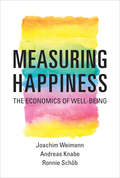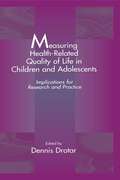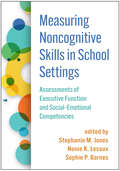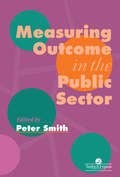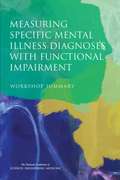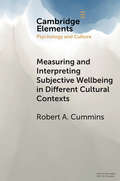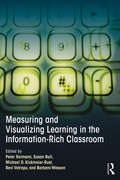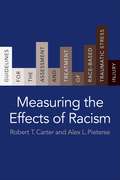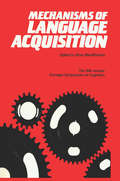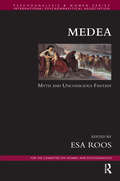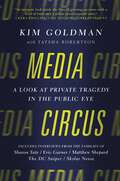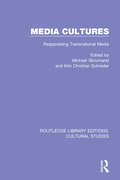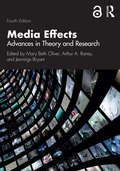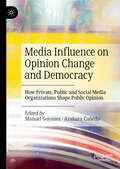- Table View
- List View
Measuring Happiness: The Economics of Well-Being (The\mit Press Ser.)
by Joachim Weimann Andreas Knabe Ronnie SchobAn investigation of the happiness-prosperity connection and whether economists can measure well-being.Can money buy happiness? Is income a reliable measure for life satisfaction? In the West after World War II, happiness seemed inextricably connected to prosperity. Beginning in the 1960s, however, other values began to gain ground: peace, political participation, civil rights, environmentalism. “Happiness economics”—a somewhat incongruous-sounding branch of what has been called “the dismal science”—has taken up the puzzle of what makes people happy, conducting elaborate surveys in which people are asked to quantify their satisfaction with “life in general.” In this book, three economists explore the happiness-prosperity connection, investigating how economists measure life satisfaction and well-being.The authors examine the evolution of happiness research, considering the famous “Easterlin Paradox,” which found that people's average life satisfaction didn't seem to depend on their income. But they question whether happiness research can measure what needs to be measured. They argue that we should not assess people's well-being on a “happiness scale,” because that necessarily obscures true social progress. Instead, rising income should be understood as increasing opportunities and alleviating scarcity. Economic growth helps societies to sustain freedom and to finance social welfare programs. In this respect, high income may not buy happiness with life in general, but it gives individuals the opportunity to be healthier, better educated, better clothed, and better fed, to live longer, and to live well.
Measuring Health-Related Quality of Life in Children and Adolescents: Implications for Research and Practice
by Dennis DrotarThis volume's purpose is to describe concepts and methods concerning assessment of health-related quality of life (HRQOL) in children and adolescents with a special focus on chronic health conditions. The impetus for this book came from a recognition of the increasing importance of HRQOL assessments in the evaluation of treatment outcomes and the need to increase the utilization of HRQOL assessments in research and clinical applications with a range of pediatric populations. The need to develop a volume that describes new research and clinical applications concerning this topic stemmed from several recent developments. There is a continuing need for evaluations of the efficacy of medical treatments for children and adolescents, including those with chronic health conditions. To address these critical unmet needs in the field of HRQOL assessment, and to advance scientific methods and clinical applications in this field, a conference was held at Case Western Reserve University. The conference set out to summarize current information concerning the development and implementation of measures of HRQOL assessment, to identify and consider key conceptual and methodological issues in research concerning the measurement of HRQOL, and to recommend priorities to advance the state-of-the-art in research and clinical applications of QOL assessment in children and adolescents with chronic health conditions. This volume summarizes and synthesizes the information that was presented by the conference participants in a series of lively discussions and chapters that were based on the presentations.
Measuring Noncognitive Skills in School Settings: Assessments of Executive Function and Social-Emotional Competencies
by Stephanie M. Jones, Nonie K. Lesaux and Sophie P. BarnesChildren's social–emotional and self-regulation skills are critical for success in school and, ultimately, in the workplace. How can educators determine the most effective approaches for measuring students' interpersonal competencies? And how can they use the data to improve their own practice? Relevant for school leaders, educators, researchers, and other stakeholders, this book brings together leading experts from multiple disciplines to discuss the current state of measurement and assessment of a broad range of noncognitive skills and present an array of innovative tools. Chapters describe measures targeting the individual student, classroom, whole school, and community; highlight implications for instructional decision making; examine key issues in methodology, practice, and policy; and share examples of systematic school- and districtwide implementation.
Measuring Outcome In The Public Sector
by Peter SmithFirst Published in 1996. Routledge is an imprint of Taylor & Francis, an informa company.
Measuring Race and Ethnicity
by Larry E. Davis Rafael J. EngelRacial and ethnic issues stand at the core of social, political, and economic concerns in an increasingly diverse America. Accordingly, how individuals from the various ethnic groups regard themselves--and others--is a salient focus of research studies across the disciplines. Measuring Race and Ethnicity gathers psychological measures of common phenomena such as racial identity, acculturation, and intra- and intergroup relations enabling researchers to compare concepts across groups and better evaluate differences and disparities. Researchers in psychology, social work, and public health examining cultural and race-related topics will find an immediately relevant source of valid and reliable scales in Measuring Race and Ethnicity.
Measuring Specific Mental Illness Diagnoses with Functional Impairment: Workshop Summary
by Engineering Medicine National Academies of SciencesThe workshop summarized in this report was organized as part of a study sponsored by the Substance Abuse and Mental Health Services Administration (SAMHSA) and the Office of the Assistant Secretary for Planning and Evaluation of the U.S. Department of Health and Human Services, with the goal of assisting SAMHSA in its responsibilities of expanding the collection of behavioral health data in several areas. The workshop brought together experts in mental health, psychiatric epidemiology and survey methods to facilitate discussion of the most suitable measures and mechanisms for producing estimates of specific mental illness diagnoses with functional impairment. The report discusses existing measures and data on mental disorders and functional impairment, challenges associated with collecting these data in large-scale population-based studies, as well as study design and estimation options.
Measuring Up: A Memoir of Fathers and Sons
by Dan Robson&“Dan Robson&’s book is a heart-wrenching portrait of grief. Anyone who has lost a parent will recognize it, know it intimately as you roll through the stages and finally come to the realization that a parent&’s ultimate gift to a child is showing them how to live.&”—Tanya Talaga, bestselling author of Seven Fallen Feathers A tender memoir of fathers and sons, love and loss, and learning to fill boots a size too big. Dan Robson&’s father is a builder, a fixer. A man whose high-school education is enough not only to provide for his family, but to build a successful business. Rick Robson holds things up. When he dies, nothing in his son&’s world feels steady anymore. In a very real sense, the home his father had built is suddenly fragile. Without its natural caretaker, the house will fall to pieces—and his family shows all the same signs of crumbling. Dan is hit especially hard. He knows he is not the man his father was. Dan never learned the blue-collar skills he admired, because his father wanted him to pursue his dream of becoming a writer. Now that his father is gone, the acknowledgment of his sacrifices and the sheer longing to be close to him again in some way draw Dan to the tools that lie unused in the garage. So begins Dan&’s year of learning the skills his father&’s hands had long mastered, and trying to fill the steel-toe boots left behind. Measuring Up is the story of that journey. Robson picks up where his father left off, working on the house and the truck, as much for the family as for himself. In much the same way that Michael Pollan comes to know his house inside-out in A Place of My Own, Robson learns the mysteries and proud satisfaction of plumbing, carpentry, wiring, and drywalling, and comes to understand how our homes are built. He also comes to see how his home was built by his father, uncovering more than one heartbreaking reminder of the kind of man his father was, and what he meant to his family. Tender and unflinching, Measuring Up is a story of love, mourning, and what it means to use your calloused hands to make the world around you a better place to live.
Measuring and Interpreting Subjective Wellbeing in Different Cultural Contexts: A Review and Way Forward (Elements in Psychology and Culture)
by Robert A. CumminsThe scientific study of 'wellbeing' involves both objective and subjective variables. While objective wellbeing can be simply measured as tangible aspects of the living environment, measuring subjective wellbeing involves quantifying self-reported feelings. Although reliable and valid measures can be achieved, in a cross-cultural context differences in language and culture present formidable challenges to measurement comparability. This Element begins by describing the behaviour of subjective wellbeing in single cultures, using the theory of homeostasis. Robert A. Cummins then discusses cross-cultural differences in subjective wellbeing, with a focus on measurement invariance as a means of ensuring the validity of comparative results. Cummins proposes that the major barrier to creating such comparability of measurement is a pervasive response bias that differs between cultures. He concludes that current instruments are inadequate to provide valid cross-cultural measures of subjective wellbeing, and that suitable measures may be created as short forms of current scales.
Measuring and Visualizing Learning in the Information-Rich Classroom
by Peter Reimann Barbara Wasson Michael Kickmeier-Rust Ravi Vatrapu Susan BullIntegrated information systems are increasingly used in schools, and the advent of the technology-rich classroom requires a new degree of ongoing classroom assessment. Able to track web searches, resources used, task completion time, and a variety of other classroom behaviors, technology-rich classrooms offer a wealth of potential information about teaching and learning. This information can be used to track student progress in languages, STEM, and in 21st Century skills, for instance. However, despite these changes, there has been little change in the kind of data made available to teachers, administrators, students, and parents. Measuring and Visualizing Learning in the Information-Rich Classroom collects research on the implementation of classroom assessment techniques in technology-enhanced learning environments. Building on research conducted by a multinational and multidisciplinary team of learning technology experts, and specialists from around the globe, this book addresses these discrepancies. With contributions from major researchers in education technology, testing and assessment, and education psychology, this book contributes to a holistic approach for building the information infrastructure of the 21st Century school.
Measuring the Effects of Racism: Guidelines for the Assessment and Treatment of Race-Based Traumatic Stress Injury
by Robert T. Carter Alex L. PieterseA large body of research has established a causal relationship between experiences of racial discrimination and adverse effects on mental and physical health. In Measuring the Effects of Racism, Robert T. Carter and Alex L. Pieterse offer a manual for mental health professionals on how to understand, assess, and treat the effects of racism as a psychological injury.Carter and Pieterse provide guidance on how to recognize the psychological effects of racism and racial discrimination. They propose an approach to understanding racism that connects particular experiences and incidents with a person’s individual psychological and emotional response. They detail how to evaluate the specific effects of race-based encounters that produce psychological distress and possibly impairment or trauma. Carter and Pieterse outline therapeutic interventions for use with individuals and groups who have experienced racial trauma, and they draw attention to the importance of racial awareness for practitioners. The book features a racial-trauma assessment toolkit, including a race-based traumatic-stress symptoms scale and interview schedule. Useful for both scholars and practitioners, including social workers, educators, and counselors, Measuring the Effects of Racism offers a new framework of race-based traumatic stress that helps legitimize psychological reactions to experiences of racism.
Measuring the Mosaic
by Rick Helmes-HayesMeasuring the Mosaic is a comprehensive intellectual biography of John Porter (1921-1979), author of The Vertical Mosaic (1965), preeminent Canadian sociologist of his time, and one of Canada's most celebrated scholars. In the first biography of this important figure, Rick Helmes-Hayes provides a detailed account of Porter's life and an in-depth assessment of his extensive writings on class, power, educational opportunity, social mobility, and democracy.While assessing Porter's place in the historical development of Canadian social science, Helmes-Hayes also examines the economic, social, political and scholarly circumstances - including the Depression, World War II, post-war reconstruction, the baby boom, and the growth of universities - that contoured Porter's political and academic views. Using extensive archival research, correspondence, and over fifty original interviews with family, colleagues, and friends, Measuring the Mosaic stresses Porter's remarkable contributions as a scholar, academic statesman, senior administrator at Carleton University, and engaged, practical public intellectual.
Measuring the Quality of Care for Psychological Health Conditions in the Military Health System: Candidate Quality Measures for Posttraumatic Stress Disorder and Major Depressive Disorder
by Elizabeth M. Sloss Susan D. Hosek Katherine E. Watkins Coreen Farris Harold Alan Pincus Carrie M. Farmer Caroline Epley Kimberly A. Hepner Carol P. Roth Grant R. Martsolf Daniel MandelTo inform improvements to the quality of care delivered by the military health system for posttraumatic stress disorder and major depressive disorder, researchers developed a framework and identified, developed, and described a candidate set of measures for monitoring, assessing, and improving the quality of care. This document describes their research approach and the measure sets that they identified.
Mechanical, Spatial & Abstract Reasoning
by Craig MackellarThis text provides an overview of key principles relating to mechanical, spatial and abstract thought. The aim is to facilitate the following learning outcomes. + Identify individual elements within a group of elements; + Identify a rule connecting a set of figures; + Complete a number of test questions by applying a rule connecting a set of figures; + Apply techniques aimed at increasing the speed at which logical rules are generated (the faster a person generates solutions, the higher the probability of a correct answer--in a given period of time); + Increase the number of elements a person can keep track of in responding to an item (span capacity). Someone with a larger span capacity than someone else can take into account more figures without making errors and hence has a larger probability of a correct answer. Mechanical, Spatial and Abstract Reasoning ability is a key element in identifying aspects of person's general intelligence. That is why the vast majority of psychometric tests will have a component that relates to abstract and spatial reasoning. This ebook will provide a measure of eductive ability or fluid intelligence which is relatively independent of specific learning acquired in a particular cultural or educational context.
Mechanisms of Age-cognition Relations in Adulthood (Distinguished Lecture Series)
by Timothy A. SalthouseThis monograph is the written version of a series of talks delivered as recent MacEachran Lectures at the University of Alberta. The informal style of the lectures, and the inclusion of a relatively large number of figures, has been preserved in order to keep the monograph faithful to the concept of an individual attempting to integrate his own research into a reasonably coherent framework. Although the volume is very much a personal account of one individual's perspective, the studies reported are naturally a product of many collaborations as well as inspirations from colleagues. The fundamental issue addressed is how adult age differences in fluid or process aspects of cognitive functioning are to be explained. Several potential mediators are considered, with most of the emphasis devoted to the investigation of working memory and processing speed as variables mediating relations between age and cognition.
Mechanisms of Change and Creativity in Nature and Culture (Elements in Creativity and Imagination)
by Arne DietrichThis Element is about change. Specifically, it's about the underlying mechanisms that cause change to happen, both in nature and in culture; what types there are, how they work, where they can be found, and when they come into play. The ultimate aim is to shed light on two barbed issues. First, what kind of system of change is culture and, second, what kind of change in that system counts as creativity; that is, what are the properties of the mechanisms of change when we explore unknown regions of the cultural realm. To that end, a novel theoretical framework is proposed that is based on the concept of a sightedness continuum. A sightedness framework for the mechanisms of change can integrate the three mechanisms causing gradual, adaptive, and cumulative change – evolution, learning, and development – into a single dimension and provide a clear view of how they cause change.
Mechanisms of Cognitive Development: Behavioral and Neural Perspectives (Carnegie Mellon Symposia on Cognition Series)
by Robert S. Siegler James L. McClellandThis volume considers how children's thinking evolves during development, with a focus on the role of experience in causing change. It brings together cutting-edge research by leaders in the psychology and neurobiology of child development to examine the processes by which children learn and those that make children ready and able to learn at particular points in development. Behavioral approaches include research on the "microgenesis" of cognitive change over short time periods (e.g., several hour-long sessions) in specific task situations. Research on cognitive change over longer time scales (months and years) is also presented, as well as research that uses computational modeling and dynamical systems approaches to understand learning and development. Neural approaches include the study of how neuronal activity and connectivity change during acquisition of cognitive skills in children and adults. Other investigations consider the possible emergence of cognitive abilities through the maturation of brain structures and the effects of experience on the organization of functions in the brain. Developmental anomalies, such as autism and attention deficit disorder are also examined as windows on normal development. Four questions drive the volume: *Why do cognitive abilities emerge when they do during development? *What are the sources of developmental and individual differences, and of developmental anomalies in learning? *What happens in the brain when people learn? *How can experiences be ordered and timed to optimize learning? The answers to these questions have strong implications for how we educate children and remediate deficits that have impeded the development of thinking abilities. These implications are explored in several chapters in the volume, as well as in the commentaries by leading discussants.
Mechanisms of Everyday Cognition
by Hayne W. Reese James M. PuckettBased on the proceedings of the twelfth biennial conference on life-span developmental psychology, most of the contributions in this volume deal with the mechanisms of everyday cognition. However, a broad spectrum of additional concerns is addressed within the domain of everyday cognition: its metatheoretical underpinnings, theory and theoretical issues, methods of investigation, empirical considerations, and social issues and applications. Addressing everyday cognition in infancy, childhood, adolescence, young and middle adulthood, and old age, this book is consistent with the chronological life-span theme of this series. The contributors collectively discuss some of the traditional concerns of life-span psychology: the dialectical nature of everyday cognition, individual differences, and contextual influences. Leading and concluding chapters provide overview, integration, and summary. In bringing together a wide array of age periods and points of view within the domain of everyday cognition, the editors hope that students and researchers in developmental psychology and cognitive science will find a useful cross-fertilization of ideas. A huge variety of theoretical perspectives is presented ranging from the position that everyday cognition and academic (laboratory) cognition are different manifestations of the same underlying processes to the position that the underlying processes are completely separate. Also of importance, a large assortment of research methods is illustrated including interviews, laboratory simulations, real-life observations and psychometric methods.
Mechanisms of Language Acquisition: The 20th Annual Carnegie Mellon Symposium on Cognition (Carnegie Mellon Symposia on Cognition Series)
by Brian MacWhinneyFirst published in 1987. Three decades of intensive study of language development have led to an enormous accumulation of descriptive data. But there is still no over-arching theory of language development that can make orderly sense of this huge stockpile of observations. Grand structuralist theories such as those of Chomsky, Jakobson, and Piaget have kept researchers asking the right questions, but they seldom allow us to make detailed experimental predictions or to formulate detailed accounts. The papers collected in this volume attempt to address this gap between data and theory by formulating a series of mechanistic accounts of the acquisition of language.
Mechanisms of Learning and Motivation: A Memorial Volume To Jerzy Konorski
by Anthony Dickinson Robert A. BoakesThis volume consists of a series of chapters honoring a Polish psychologist and neurophysiologist who died in 1973. Although his name was familiar to all of the contributors, many had had no personal contact with him and had gained acquaintance with his ideas only through his publications.
Medea: Myth and Unconscious Fantasy (Psychoanalysis and Women Series)
by Esa RoosThis book takes Euripides tragedy of Medea as its starting point. Our unconscious fantasies can be embedded in age-old myths, and many modern works about Medea reflect our ever-present interest in such myths. The Danish film director T.H. Dreyer had plans to produce a film about the story of Medea, while his countryman Lars von Trier did in fact make his own version of Medea, based on Dreyer`s previous work on the theme. In this remarkable new book the `Medea fantasy is introduced as an unconscious determinant of psychogenic sterility, a fantasy that may form an unrecognized and dissociated part of the self-representation. The book describes how this can lead women to believe that their lovers (like Jason in the original myth) will deceive and abandon them, and that this anxiety might cause them to react violently towards their children. For such women it is imperative to forgo any creative femininity.
Media Circus: A Look at Private Tragedy in the Public Eye
by Kim Goldman Tatsha RobertsonImagine losing a loved one in the public eye. A media frenzy ensues and spreads your family name through the news. Reporters ambush you, and across the country, strangers gossip about your personal loss. Welcome to the circus. No one understands better than Kim Goldman the complex emotions of individuals suffering a personal tragedy under the relentless gaze of the media. During the famed O.J. Simpson trial, Kim, whose brother, Ron Goldman, was brutally murdered, became the public poster child for victims suffering in the public eye. In Media Circus, Goldman, now a dedicated victims' advocate who works with families across the country, presents the first collective look at these ordinary, grieving victims—forced to manage their very private trauma and despair in a very public way. Through candid interviews and detailed, original reporting, Media Circus delivers riveting, humanizing, and inspiring stories from the victims and survivors of violent crimes who found themselves the focus of national media attention. Its heartfelt narratives showcase the unique challenges of coping with and healing from grief when the whole world is watching. In these pages, the families of other victims tell their stories, including: Esaw And Emerald Garner, wife and daughter of police brutality victim Eric Garner (2014) Scarlett Lewis, mother of six-year-old Newtown tragedy victim Jesse Lewis (2012) Debra Tate, sister of Charles Manson murder victim Sharon Tate (1969) Judy Shepard, mother of gay hate-crime victim Matthew Shepard (1998) Mildred Muhammad, ex-wife of the DC Sniper (2002) Tere Duperrault Fassbender, survivor of family's brutal murder at sea (1961) Collene Campbell, sister of murdered NASCAR driver Mickey Thompson (1988) Marie Monville, wife of the Amish Shooter (2006) Dave And Mary Neese, parents of teen murder victim Skylar Neese (2012) Scott And Kathleen Larimer, parents of Aurora theater shooting victim John Larimer, and Shirley Wygal, mother of Aurora theater shooting victim Rebecca Wingo (2012) Media Circus goes beyond the names and faces to show the real victims behind the stories.
Media Cultures: Reappraising Transnational Media (Routledge Library Editions: Cultural Studies)
by Michael Skovmand Kim Christian SchrøderThis book, first published in 1992, challenges the elitism and cultural pessimism of much Anglo-American and Continental cultural debate with regard to the role and power of transnational media practices. In a series of ten innovative essays, an international group of media researchers explores a wide range of cultural practices across national borders and the cultural politics associated with these everyday practices and debates.
Media Effects: Advances in Theory and Research (Routledge Communication Series)
by Jennings Bryant Mary Beth Oliver Arthur A. RaneyNow in its fourth edition, Media Effects again features essays from some of the finest scholars in the field and serves as a comprehensive reference volume for scholars, teachers, and students. This edition contains both new and updated content that reflects our media-saturated environments, including chapters on social media, video games, mobile communication, and virtual technologies. In recognition of the multitude of research trajectories within media effects, this edition also includes new chapters on narratives, positive media, the self and identity, media selection, and cross-cultural media effects. As scholarship in media effects continues to evolve and expand, Media Effects serves as a benchmark of theory and research for the current and future generations of scholars. The book is ideal for scholars and for undergraduate and graduate courses in media effects, media psychology, media theory, psychology, sociology, political science, and related disciplines.
Media Influence on Opinion Change and Democracy: How Private, Public and Social Media Organizations Shape Public Opinion
by Manuel Goyanes Azahara CañedoThis book reviews and advances the theoretical and empirical knowledge at the intersection of opinion change and democracy. Specifically, the volume addresses how opinion change and political persuasion unfold in three main domains of media effects: private media (i.e., news organizations), public service media (state-own media services), and social media platforms. Divided in these three different sections, the volume serves as a venue to discuss and further advance the most recent theoretical assumptions and empirical findings that underpin our current understanding on how media influence public opinion and shape liberal democracies. The book also explores how media literacy and critical thinking can mitigate the effects of misinformation and propaganda, emphasizing the importance of educating the public to discern credible information from deceptive content. Furthermore, it discusses the ethical implications of media practices and the responsibilities of media producers in maintaining the integrity of democratic discourse. By highlighting these aspects, the book provides a comprehensive understanding of the complex interplay between media, public opinion, and democracy, offering valuable insights for scholars, policymakers, and anyone interested in the role of media in shaping public opinion.
Media Moms & Digital Dads: A Fact-Not-Fear Approach to Parenting in the Digital Age
by Yalda T UhlsIs social media ruining our kids? How much Internet activity is too much? What do FOMO (Fear of Missing Out), sexting, and selfies mean for teens? Are you curious about what research says about how media and technology are affecting childhood? Supported by academic research focused on technology, Media Moms & Digital Dads breaks down complex issues in a friendly, accessible fashion, making it a highly useful and, ultimately, reassuring read for anyone who worries about the impact that media might be having on young minds. Each chapter delves into a different issue related to kids and media so parents can easily find their particular issue of concern. Dr. Uhls ends each chapter with quick takeaways, in the form of tips and guidance for parents. Dr. Uhls' expertise as a former Hollywood film executive and as a current expert on child development and the media gives her a unique and important perspective. As a trained scientist she understands the myriad studies conducted by researchers, and as a mom of digital teens, she knows what actually works and can relate to the reality of being a parent in the 21st century. Dr. Uhls also describes the primary research she conducted at UCLA, including whether extensive screen time impacts non-verbal emotional understanding, which has been covered in the New York Times, Time magazine, and on National Public Radio. There are few more important issues for parents today than helping children safely navigate the digital world in which we live, a world that provides immense opportunity for learning and connecting yet also puts kids in a position to make mistakes and even cause harm. Knowing what the facts are and when and how to get involved is perhaps one of the most challenging aspects of modern parenting. Media Moms & Digital Dads offers parents reassuring and fact-based guidance on how best to manage screens and media for their children.
